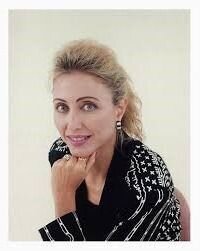
When you think of Diane Freis, your first thought might well be color, followed very shortly by print-mixing and bohemian. Her 1980s’ vibrantly patterned, easy-fit and flowing styles are bestsellers in the vintage world, beloved for their quality and distinctive sensibility.
Recently, the VFG’s Anne Cook (Vintage Baubles) had the opportunity to talk with Diane about her history in design, and found out what this self-proclaimed “wild artist” is up to now.
Q: Would you tell us a little about your early life? Where you grew up, what interests you had, that type of thing?
A: I was born and raised in Los Angeles (about a century ago—lol) and have great memories of growing up in a suburban, rural, and safe environment. My father was a lawyer, and my mother was his legal secretary, which worked out very well. I have three older sisters, making me the youngest of four girls.
Susan, sister number two, and I shared a great passion for art. We used to take special walks after school to find beauty in the neighborhood. We often brought sketch pads with us so that we could sit down and draw something that captured our attention. Our favorite subjects were horses, rose gardens, and sunsets, but we were happy to explore and discover other sources of inspiration as well.
On my mother’s side of the family, there was a connection to the fashion industry. My grandfather was a designer/tailor. He had a workshop in the back of his house equipped with a cutting table, sewing machine, fabrics, etc. He designed and made couture, tailor-made clothing for his private clientele. It was a bit ironic that later on in life my mother’s closet displayed a collection of his exquisitely made silk blouses, cashmere coats, and precision-cut European suits that her father made for her and also my very colorful bohemian dresses.
I studied fine art for my major at UCLA. Going to classes to advance my knowledge of art history, drawing, painting, animation, and all related fields was a perfect time in my life. The education that I received during those years left me in good stead for my future journey.
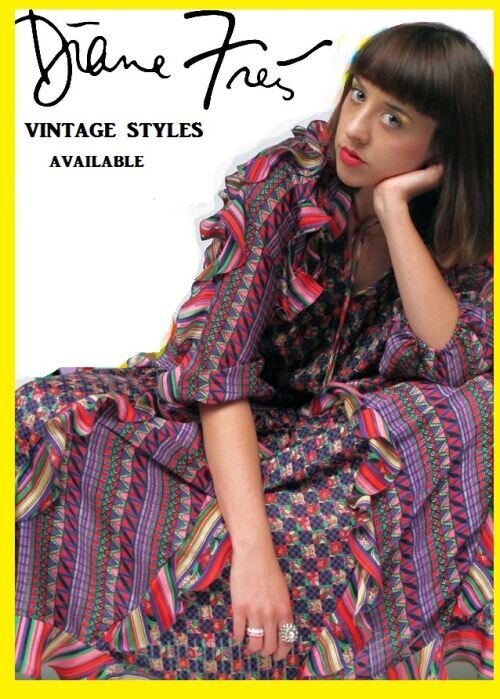
The colorful, mixed-print bohemian look of the ’80s
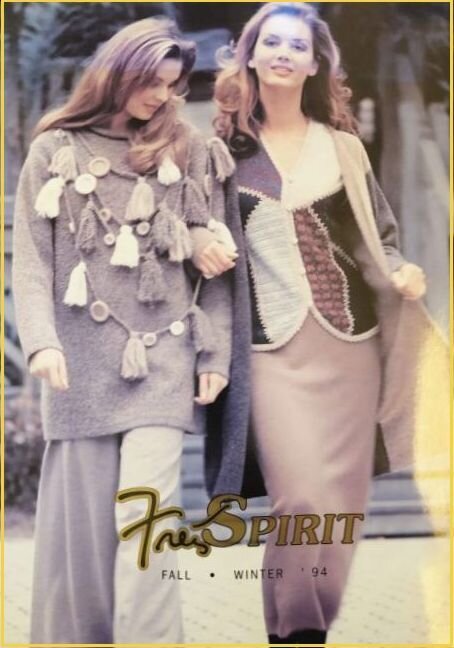
From the “Freis Spirit” line
Q: What inspired your interest in fashion design, and how and when did you get started as a designer?
A: I graduated UCLA and received my Bachelor of Fine of Arts in the spring of 1972. I was planning on returning in the fall to start a master’s program. However, in the ensuing summer period, several events occurred, which I now believe were a precursor to both—my destiny in becoming a fashion designer, as well as altering my future direction in life.
The first event occurred while I was shopping in a local mall during the summer holidays. As I was looking around at all the items on display in the shops, I noticed that the garments were devoid of artistic merit, instead being designed for the single purpose of being wearable. Blue jeans matched with striped or plain colored T-shirts were the “in look” in every store window in Hollywood. I think the big ad campaign that summer was the “Marlboro Cowboy,” who looked rough and ready in his trendy blues, lighting up a smoke and staring off into the sunset.
As I had just spent four years studying art, art history, and the significance of art’s relation to culture, I realized that an artistic approach to fashion design was absent in the boutiques and department stores. I wanted to embrace this void and make it my personal mission to bridge this gap. At the same time, it was just a coincidence that a friend of mine was creating new fashion by recycling swap-meet fabrics into her collection. The idea appealed to me, and I went ahead and bought my own fabrics that were textured, embroidered, and/or embellished and came up with a new idea to make patchwork jean jackets with an artistic edge. I hand-stitched the interesting fabrics into the seams of both the front and back panels of the jacket. The sleeves were cut off and replaced by a cascade of curled feathers around the entire armhole, altering the jacket style into a vest. My first collection of six hand-made colorful and wild jeans vests were ready to take a ride in my Chevy en route to Hollywood and my first appointment of the day.
Bazaar CM was a trending boutique along the Hollywood strip. It was jointly owned by Choi and Matsako, a Chinese and Japanese partnership. Choi greeted me at the entrance of the boutique, viewed the wild creations in my hands, asked the price for each item, which was $25 (USD) per piece, and quickly wrote me a check for the entire group. What I didn’t realize at this time was the significance of this first sale. I had no idea that my future would be in Hong Kong (China) and that my polyesters for my future collections would mainly be printed in Japan.
Choi called me a few days later and told me that some celebrities had bought the vests. Among the names were Joni Mitchell and Diana Ross. She wanted to order another six vests and emphasized that I rush the order. By the end of the summer, I was selling the artistic jean vests to many shops in Hollywood and had abandoned my plans to return to University. I had too many orders on hand and was forced to hire a sewing girl, as well as open a small studio in Santa Monica. I also created another look, which in turn did well: a re-vamped box-shaped Eisenhower jacket made from richly textured materials. Every piece was different and special in some way. Orders kept coming in until I reached a point in time when I needed to find new inspiration.
I had a very close Chinese friend, who had moved back to Hong Kong after University. I decided to visit her, as I thought that I might find inspiration in Chinese silk fabrics. I made the visit and felt very welcome on the streets of Hong Kong. It was a different culture in those days, but still very inviting. The Chinese Arts and Crafts Department stores displayed the finest dyed and embroidered silks that I had ever seen. I found a backstreet tailor and designed and ordered some colorful, embroidered flowing silk tops along with matching skirts. I returned to Los Angeles, sold the new look to my accounts and realized that I needed to relocate to Hong Kong. The lure of silk fabrics, the complying Chinese manufacturing resource, and the opportunities to explore that “artistic void in fashion” were attracting me to the Far East. Although living in Hong Kong was a great adventure, the first significant opportunity came through the Hong Kong Trade Development Council, who were hosting a Young Designers’ Show. They invited me to participate. I came up with the mixed print dress with a flexible elasticated waist. This was the first launch of the ‘80s’ bohemian influence, which ended up selling first in Hong Kong boutiques and department stores before the Diane Freis brand was sold internationally.
Q: Your prints were pretty ground-breaking for the times. Did you set out to be an innovator, or did it “just happen”?
A: Well, I’ve covered the point that I was aware that art had not been connected to fashion in a significant way. You can say there were many pieces of the puzzle that came into play on a timely basis to make it all happen. I was connected to a realization that needed to be addressed, and I did allow my inner voice to override the more conservative or conventional approaches. If you are destined to be an innovator, something needs to be passed down in your DNA.
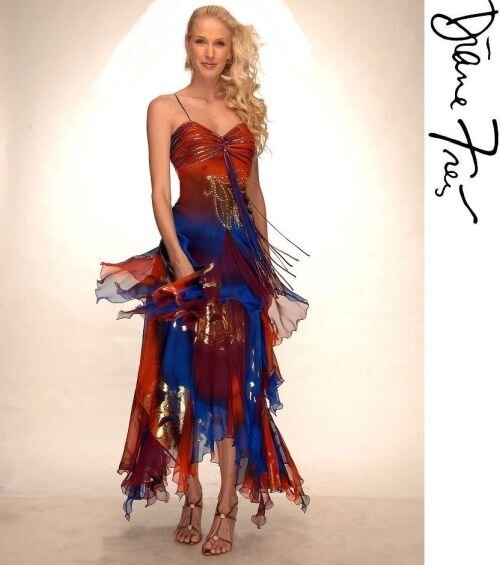
Dress made from hand-painted silk fabric
Q: How did you move into manufacturing your own line? Is that something you’d intended, or did it evolve more naturally?
A: Every designer needs a team of people. Coming up with a collection and producing inventory requires both a back and front office of talented and hard-working people. I needed my own manufacturing so that I could have daily meetings with the all the staff. Although my approach to design was new and brazen, it was working well and flourished everywhere. What I enjoyed the most was the trust that was established within the supply chain and manufacturing sectors. I was able to focus on the quality and originality of every design because the operation was all under one roof. I had a great team of people that helped me source and connect so that implementation was achievable.
Q: You’re noted for your dresses, particularly the boho, flowy styles. But you did do some separates, correct? Are there lines you designed that would surprise people?
A: My original bohemian ‘80s’ dress and all the style versions of the easy fit collection are well known to the industry. Those are the years that the brand flourished as it changed the direction of fashion in a very significant way. The success of that launch spawned many, many copy lines.
I also launched another brand in the ‘80s, “Freis Spirit,” which was comprised of an assortment of new looks each season. The line was primarily sold in the Diane Freis Hong Kong Boutiques. It was a great diversion line for customers, who already had many of the colorful dresses and were looking to add different pieces to their wardrobe.
Along the way, I also collaborated with a knitwear company in the U.S., Marisa Christina, and worked with them on the launch of a new label, “Diane Freis for Marisa Christina.” The collection comprised matching knitwear tops/woven skirt combos. The skirts were printed and easy fit. The knitwear incorporated the theme of the print, and the sleeves of the knit were made from the printed fabric. The collection sold well in the U.S. market, particularly in the major department stores that also sold the dresses.
I showcased a new printed evening wear collection at Hong Kong Fashion Week in 2005. A prominent U.S.-based prom company was appointed to distribute the new look into the U.S. market. The look was a hit, and suddenly printed prom and evening dresses were in vogue. Unfortunately, in the following seasons, cheap copies tried to knock off the look, but the better quality boutiques still sold the brand well.
Another new look that I explored in 2011 was printed cruise wear. Caftans, tunics, ponchos, camis, blouses, and coordinates gave easy fit loungewear a new contemporary vibe.
I also worked on a range of mother-of-the-bride dresses and gowns at one stage, when a California-based sales rep begged me to design a new look that made the MOB look more upbeat and modern.
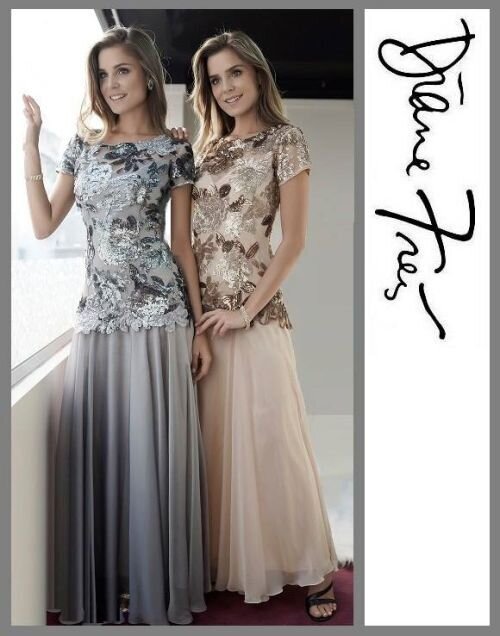
Tradition-breaking mother-of-the-bride look
Q: You closed your business a few years ago. Looking back on it, what did you enjoy the most about it? The least?
A: Inside me is a wild artist, always willing to explore and develop new ideas. In the past, I had the support at times of a fabulous team of people who helped me achieve a great height of success when the company was on fire. Personally, I feel fully engaged and connected to life when I am exploring fashion challenges. What I like least about the fashion business is when your connections—reps, distributors, manufacturers or close connections—can’t be trusted. It’s the ugly part of the industry.
Q: You have some unsold inventory left. What are your plans for that?
A: Yes, when I closed my offices in Hong Kong recently, I had to box up some unsold dresses. They are currently being stored in a container in Hong Kong. They are in new condition, and I welcome the opportunity to engage with professionals in the industry who would like to sell these vintage pieces.
Q: Are you looking for a large company to distribute these pieces, or are you willing to sell in small quantities to individual sellers?
A: I actually would prefer to sell the vintage pieces in small quantities to either online boutiques or shop owners. There is a wonderful, eclectic variety of styles in this vintage “unused” inventory. Included are some original ‘80s’ dresses (still with tags), tunics and separates, silk evening cocktail dresses and gowns, original samples, basic items (chiffon camis and pants), and other unique one-of-a-kind items. It’s really a potpourri of styles that is a representation of fashion directions for the Diane Freis brand.
Q: What do you think your future holds? Do you have concrete plans? I know you’re still creating beautiful art. Do you ever think of having a second career as an artist in other media? What about going back into design? Do you feel pulled back to it?
A: “Yes” to all the questions above. Life can offer the opportunity to explore, but there are also times to be patient and grow in other ways. At every stage of the journey is a surprise waiting around the next corner. In hindsight, most of it makes sense. But sometimes when you are in the midst of change, it can be overwhelming. The fashion industry is in my DNA.
Q: For those of us who love your designs and who would like to see more of them, including the artwork that you’ve created, where is the best place to view these?
A: I post artwork on Instagram, Facebook, and Pinterest on a weekly basis. The artwork is personal and gives me the chance to display creative ideas to an audience at large.
I welcome the opportunity to connect with other individuals or entrepreneurs, who either love the Diane Freis brand or have a passion for selling unique, quality vintage items.
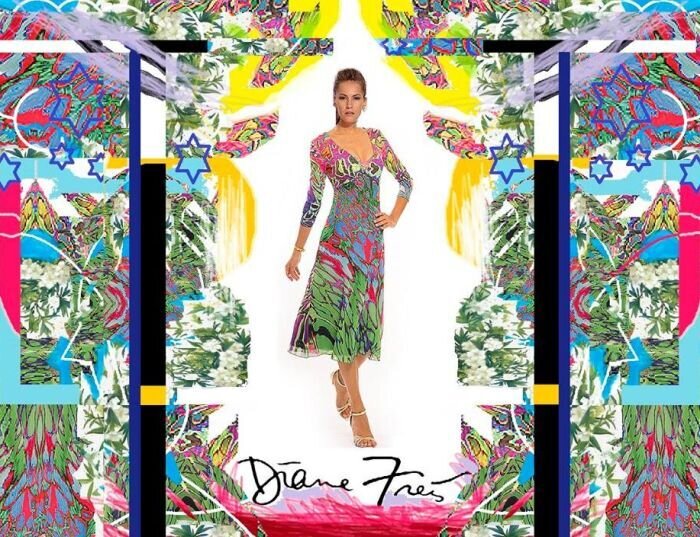
Digitally printed fabric designed by Diane in an Italian studio
For more information about purchasing Diane Freis pieces, contact Anne/vintagebaubles at Anne@vintagefashionguild.org